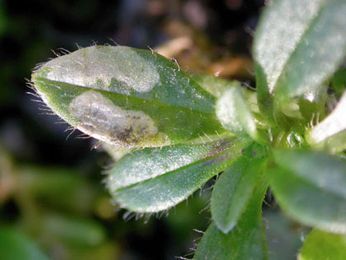|
||||||
|
MORICANDIA. Violet Cabbage. [Brassicaceae] |
|
Only one species of Moricandia, Violet Cabbage (M. arvensis), is recorded in Britain. It is introduced. The BSBI provide a downloadable plant crib for Brassicaceae. Four British miners are recorded on Moricandia. A key to the European miners recorded on Moricandia is provided in Bladmineerders van Europa. |
Key for the identification of the known mines of British |
1a > Leaf and stem mine: Oviposition takes place in the leaf blade where a short mine is formed until the larva reaches the nearest vein which is then followed downwards, with the main feeding occurring in the mid-rib, petiole, or in young plants, also in the stem (Spencer, 1976: 490). Pupation either internal or external. The mine begins somewhere in the leaf, generally at the lower surface, not far from the leaf margin. From there a corridor runs randomly, until it hits upon a vein. The corridor then follows this vein until it reaches the midrib. Then the larva starts to bore into the midrib, and may descend into the petiole or even the stem. Pupation may take place either within or outside the mine. |
|
Phytomyza rufipes Meigen, 1830 [Diptera: Agromyzidae]. |
1b > Leaf-miner: A distinctive mine primarily above mid-rib, with irregular short lateral offshoots into leaf blade. Pupation external (Spencer, 1972: 51 (fig. 172), 55; Spencer, 1976: 270, 271 (fig. 486)). Branched, whitish, upper-surface corridor; main axis overlying the midrib; side branches overlying the main lateral veins. (In Campanula and Phyteuma the mine is much less branched, sometimes nothing more than a corridor on top of the midrib). Frass in rather long strings. Usually the mines begins as a long and narrow, shallow, tortuous lower-surface corridor that ends upon the midrib but otherwise is not associated with the leaf venation. Often this initial corridor is filled with callus, and then even less conspicuous. Pupation outside the mine. A linear mine on the upper surface, usually following the midrib and showing side branches along the veins. The frass is in strings. |
|
Liriomyza strigata (Meigen, 1830) [Diptera: Agromyzidae]. |
1c > Leaf-miner: Corridor-blotch mine, normally dorsal; usually whitish; in small leaves it lies characteristically in the centre of the leaf often touching the petiole; in larger leaves it lies to one side of the mid-rib. Frass deposited in green clumps near the leaf margin. Pupation usually external, sometimes in a separate pupation mine. Oviposition whitin the leaf, at the lower surface. The first part of the mine is a long, sometimes very long, corridor, that mostly will be overrun by the later developments. Generally this corridor is directed, frequently guided by a thick vein, to the midrib. The next section of the mine is large, irregular blotch overlying the basal section of the midrib. Locally large chunks of midrib tissue are consumed. From this central blotch excursions are made into the leaf blade: generally upper-surface, less often lower-surface and locally full-depth. In plants with narrow leaves, like Diplotaxis, the mine may occupy the entire width of the leaf. Often several larvae together in a mine. Frass blackish green, powdery, in clouds, sometimes along the sides of the corridors, later more in the periphery of the mine and in the end of extensions of the blotch, sometimes seemingly absent. (Often the frass can only be seen after the mine has been opened). Pupation generally in the ground, rarely within he leaf, in a short mine without frass. Hendel (1928a) described the biology, larva and puparium. An initial narrow gallery then leads to a blotch on the midrib of the leaf. Watch a video of a scaptomyzid fly larva on Arabidopsis on YouTube by mash92587. |
|
Scaptomyza flava (Fallén, 1823) [Diptera: Drosophilidae]. |
1d > Leaf-miner: The mine starts as a long, narrow, winding corridor running towards the midrib, widening to a blotch. Usually upper-surface, but in small leaves also full-depth parts may occur. The blotch has broad lobes; in their ends most frass is accumulated in the form of green patches or clouds. Sometimes several larvae share mine. Pupation usually in the soil, less often in the leaf (and then generally not in the mine itself but in a small separated mine, that may even be made in the petiole). |
 Mine of Scaptomyza graminum on Cerastium glomeratum Image: © Jean-Yves Baugnée (Bladmineerders van Europa) |
|
Scaptomyza graminum (Fallén, 1823) [Diptera: Drosophilidae]. |
| Last updated 06-Jul-2019 Brian Pitkin | ||
